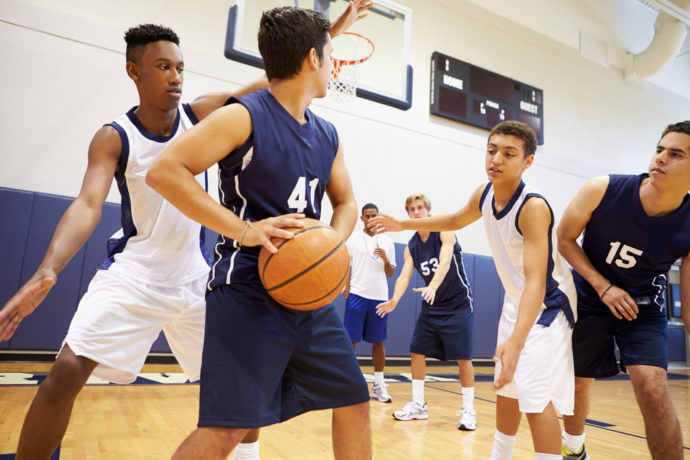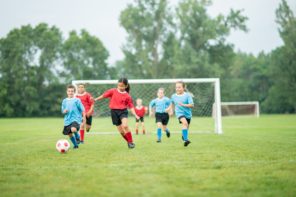Student athletes learn so much throughout their journey in school—teamwork, how to win, how to lose and also how to avoid injury. It’s important to stay safe throughout the season.
Parents often come to me with visions of their child competing in the Olympics or becoming the star athlete in a professional sports team. Like everything in life, those dreams can become complicated as parents and student-athletes work toward making them a reality.
For example, when I get a new high school athlete who has played only baseball his entire life and is already experiencing tendinitis in his throwing shoulder, that’s when I hit the brakes.
Why?
The injury is most likely due to sports specialization, or playing and training for a single sport year-round. It can lead to all kinds of injuries that can reduce your child’s chances of achieving those dreams. In a case like this, we face an uphill battle. Alleviating overuse injuries in-season or without appropriate interventions like rest, is difficult. Convincing parents, coaches and athletes that rest is necessary is even harder! No one likes to feel like they are falling behind the competition when taking time away from a sport.
The National Athletic Trainers’ Association (NATA) has designated the third full week of October (Oct.17-21) as National Youth Sport Specialization Awareness Week to increase the awareness of injury risk related to sport specialization and help keep athletes safe and healthy as they head back to school.
So what can you do as a parent?
Here are some NATA back-to-school sports safety tips to help the athletes in your family keep reaching for the stars.
- Delay specializing in a single sport: Sport specialization is often described as participating and/or training for a single sport year-round. Young athletes should strive to play and try a variety of sports. Playing multiple sports allows for all-around improved physical fitness and athletic skills, such as balance, eye-hand coordination, speed, power, flexibility, and endurance. A well-rounded athlete is a much better athlete!
- One team at a time: Teens and young athletes should participate in one organized sport per season, and for only one team/league per season
- Less than eight months per year: Teens and young athletes should not play a single sport more than eight months per year. This allows for the structures primarily stressed in one sport to rest and for others to develop.
- No more hours/week than their age: Teens and young athletes should not participate in sports more hours per week than their age (i.e., a 12-year-old athlete should not participate in more than 12 hours per week of organized sport).
- Two days of rest per week: A minimum of two days off per week from organized training and competition is recommended. Athletes should not participate in other organized team sports, competitions and/or training on rest and recovery days.
- Rest and recovery time from organized sport participation: Athletes should spend time away from organized sport and/or activity at the end of each competitive season. This allows for both physical and mental recovery, promotes health and well-being and minimizes injury risk and burnout/dropout.
Other safety tips for a safe sports school year:
- The school’s sports medicine team: Find out who will provide care to your child in case of an injury and ask to review their credentials. NATA recommends that any medical decisions are made by the school’s sports medicine professionals, physicians and athletic trainers (ATs), and not the coach to avoid conflict of interest. Coaches and even the athletes themselves may unconsciously make decisions that favor winning over safety.
- An emergency action plan: Every team should have a venue-specific written emergency action plan (EAP) for managing serious and or potentially life-threatening injuries. It should be reviewed by the AT and local Emergency Medical Service. Individual assignments, emergency equipment and supplies need to be included. If an AT is not employed by the school, other qualified individuals need to be present to render care.
- AED and someone who knows how to use it: AEDs can save a life and stave off a catastrophic situation. Ensure that the sports medicine team and other personnel know where they are located and how to use them. They should be readily available within three minutes (preferably one minute) during both practices and games.
- Educate yourself further: Did you know only 37% of U.S. public high schools have a full-time AT? Schools that employ at least one full-time AT, the gold standard of care recommended by NATA, are better prepared to protect student athletes during the school year. Visit NATA’s public educational website, www.AtYourOwnRisk.org that provides comprehensive information on reducing risk of injury in work, life and sport. Watch the Tips for Parents video on back-to-school sports safety and download the Youth Sport Specialization Safety Recommendations.
Jennifer Rheeling, MS, ATC, is a certified athletic trainer and a 30+-year member of National Athletic Trainers Association. She currently serves as the chair of NATA Secondary School Athletic Trainers’ Committee and has devoted her career to protecting the health and safety of adolescent athletes. She is currently in her 32nd year as an athletic trainer with the DC Public School system and is the head athletic trainer at HD Woodson Senior High School.





